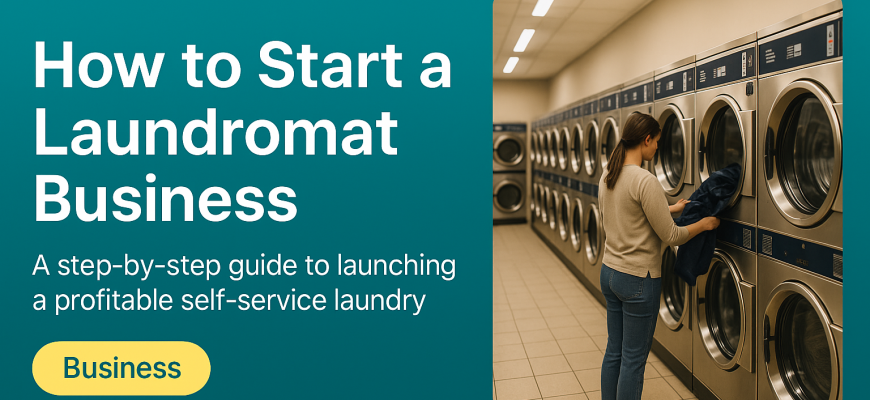Starting a laundromat business is an exciting opportunity to provide a vital service to your community while achieving financial independence. As a business coach for women entrepreneurs, I’ve seen firsthand how empowering it is to build something from the ground up. The laundromat industry is particularly attractive—approximately 95% of laundromats succeed within their first five years (far higher than the average small business), and owners enjoy a healthy 20–35% return on investment on average. In other words, with the right planning and execution, your laundromat can become a stable, profitable venture. In this step-by-step guide, we’ll walk through everything from initial market research to opening day. Each section provides practical steps and motivational tips to help you move forward with confidence. Let’s dive into the process of launching your laundromat from scratch!
- Step 1: Conduct Market Research and Plan Your Business
- Step 2: Secure a Location for Your Laundromat
- Step 3: Choose the Right Equipment and Layout
- Step 4: Arrange Financing and Budget for Startup Costs
- Step 5: Handle Licensing, Permits, and Legal Requirements
- Step 6: Hire Staff (If Needed) and Organize Operations
- Step 7: Market Your Laundromat Business
- Step 8: Prepare for Opening Day (Grand Opening Tips)
- Empowering Your Entrepreneurial Journey
Step 1: Conduct Market Research and Plan Your Business
The first step is understanding the market you’re entering. Take time to assess the local demand for a laundromat in your target area. For example, look for neighborhoods with many renters, college students, or dense apartment housing – areas with high renter populations and lower-income households often signal strong demand for public laundry services. Also, scope out the competition: identify existing laundromats nearby and note their services, pricing, hours, and machine quality. This research will reveal gaps or opportunities (perhaps no laundromat offers late-night hours, or none provide large-capacity machines) that your new business can fill. The goal is to learn as much as possible about your future customers and competitors so you can make informed decisions and minimize risks.
After gathering market insights, turn your attention to creating a business plan. A solid business plan is your roadmap – it forces you to outline your laundromat’s mission, target market, startup and operating costs, and revenue projections. It should detail your services (self-service only or additional options like wash-and-fold), marketing and sales strategies, and financial forecasts for the next 3-5 years. Writing a business plan might seem daunting, but it’s a crucial step that will guide your actions and help convince lenders or investors that your laundromat is a sound investment. Stay realistic with your numbers and set clear goals. Remember, planning now saves headaches later and sets you up for success.
Step 2: Secure a Location for Your Laundromat
Your laundromat’s location will greatly influence its success. Ideally, you want a spot that is convenient and highly visible to your target customers. Start by focusing on high-demand areas uncovered in your research—places with lots of apartment complexes, student housing, or neighborhoods without in-unit washers/dryers. Look for a location that has plenty of foot traffic or is on a well-traveled street, and ensure there’s adequate parking and easy access for customers with baskets of laundry.
Beyond customer convenience, evaluate the site’s practical suitability. Check that the building is zoned for commercial use and can support the necessary utilities (plumbing, electrical, ventilation) that heavy-duty washers and dryers require. If you’re considering a spot that needs renovation, factor in those costs and permitting time. It’s also wise to be aware of nearby competitors: an area saturated with laundromats might be tougher to break into, unless you have a plan to offer something better or different (such as superior service, cleaner facilities, or unique amenities). Take your time visiting potential locations at different times of day to observe traffic patterns and safety. Once you’ve found a promising location, you can negotiate a lease or purchase and start laying the groundwork for your storefront.
Step 3: Choose the Right Equipment and Layout
With a location secured, you’ll need to equip your laundromat with the right machinery and amenities. The washers and dryers you select are the heart of your business, so invest in reliable, commercial-grade machines. Consider the capacity and efficiency of each unit: offering a mix of sizes (for small loads up to bulky items) will attract more customers, and energy-efficient models can save on utilities in the long run. It’s often worth purchasing new or high-quality machines with warranties, as they’ll be less prone to breakdowns – a machine out of order is lost revenue and a potential customer service issue. Also plan for enough machines to handle peak times. If you expect, say, 15 customers during busy hours, aim for at least 15 washers so no one has to wait long to start their laundry.
Don’t forget the supporting equipment that makes your laundromat convenient and user-friendly. Some essentials include:
-
Change machines or payment systems: If your machines are coin-operated, have a change machine available. Alternatively, consider a card or mobile app payment system for modern convenience.
-
Laundry carts and baskets: Provide rolling carts or baskets so customers can easily transfer loads between washers, dryers, and folding areas.
-
Folding tables and seating: Set up ample table space where people can fold clothes, and include a seating area for those waiting. Comfortable chairs, benches, or even a kids’ play corner can enhance the experience.
-
Vending machines for supplies: A simple vending machine with detergents, fabric softener, dryer sheets, or even snacks and drinks can generate extra income and help customers who forgot their supplies.
-
Security and maintenance: Install a security camera system for safety and to deter theft or vandalism. Also equip a back room or closet with cleaning and maintenance tools (mops, trash bins, basic repair kits) so you or staff can keep the place tidy and fix minor issues quickly.
By thoughtfully choosing your equipment and layout, you set the stage for an efficient operation. Durable machines, a smart floor plan, and handy amenities will not only attract customers but also make daily management smoother for you.
Step 4: Arrange Financing and Budget for Startup Costs
Starting a laundromat requires an upfront investment, so the next step is to figure out financing and create a realistic budget. Laundromats can have a wide range of startup costs – anywhere from around $50,000 to over $500,000 to get up and running. The exact figure will depend on factors like the number of machines, whether you’re renovating a space or building out a new one, and local real estate prices. Be sure your budget accounts for all major expenses: commercial washers and dryers (often the biggest cost), plumbing and electrical work to install them, any building renovations, your first few months’ lease or mortgage payments, insurance, initial inventory of supplies, and a cushion for utilities and operating expenses until you break even. It’s better to over-estimate costs than to run out of funds before the business gains traction.
To fund your laundromat, consider the financing options available and choose what fits your situation. Many entrepreneurs start with a traditional bank loan or a Small Business Administration (SBA) loan, which can offer lower interest rates for those who qualify. Prepare to present your business plan and market research to lenders as evidence that your venture will succeed. Another route is equipment financing – some equipment manufacturers or specialty lenders provide loans or leasing programs specifically for laundry machines. This can spread out the cost of pricey washers and dryers over time. Additionally, you might use personal savings or bring in investors/partners if that’s an option, but make sure any partnership agreements are clear from the start. However you finance your laundromat, borrow conservatively and keep an eye on your debt obligations; you want to maintain healthy cash flow once you’re in operation. With funding secured and a solid budget, you’re one step closer to opening your doors.
Step 5: Handle Licensing, Permits, and Legal Requirements
Like any business, a laundromat must comply with certain legal and regulatory requirements. This step isn’t the most glamorous, but it’s essential to get everything in order so you can operate without hiccups. Start by choosing a formal business structure (such as sole proprietorship, LLC, or corporation) and registering your business with the appropriate authorities. Many laundromat owners opt for an LLC or corporation to protect their personal assets – these structures provide liability protection, meaning if there were ever a lawsuit (for example, a customer injury on-site), your personal finances are more shielded. Consult with an attorney or utilize small business resources to determine the best structure for you and to file the necessary paperwork (like Articles of Organization for an LLC). Don’t forget to also register your business name (and check that the name is unique in your state) and obtain an Employer Identification Number (EIN) from the IRS for tax purposes.
Next, secure all permits and licenses required to legally run your laundromat. Specific requirements vary by location, but generally you will need a basic business license from your city or county to operate, as well as permits related to building safety and utilities. For example, you may need water usage or wastewater permits given the high volume of water your machines will use, and building permits or inspections if you performed renovations or installed new equipment. Health and safety regulations might require an inspection (ensuring things like proper dryer ventilation and no electrical hazards). Don’t overlook fire department regulations (dryer lint traps and electrical wiring should meet code) and any required signage permits for your outdoor signs. If you plan to sell items on-site (even just detergent packs or snacks), you’ll also need a sales tax permit in many jurisdictions. It’s a lot of paperwork, but your local small business office or a business attorney can guide you through it. Tackle this step well before your opening day—some permits can take weeks for approval. Once you have all the licenses and permits in hand, you can operate with peace of mind, knowing your business is on solid legal ground.
Step 6: Hire Staff (If Needed) and Organize Operations
One appealing aspect of a laundromat business is that it can be run with minimal staff – or even none on-site at certain times – especially if you set up an automated, self-service model. Many small laundromats are unattended, with the owner or a cleaner stopping by only to maintain machines and keep the place clean. This keeps labor costs low. If you plan to run an unattended laundromat, you’ll still want someone (possibly yourself) to handle daily cleaning, machine upkeep, and customer inquiries via phone or posted contact info, but you might not need full-time employees on the floor. On the other hand, if you choose to offer additional services like a wash-and-fold laundry service or dry cleaning pickup/drop-off, you will need to hire staff to manage those tasks. A self-service laundromat typically needs far fewer attendants than a full-service laundry – for instance, a wash-and-fold operation usually requires at least a couple of employees to cover all the work efficiently.
Carefully consider your staffing needs based on your business model. If you decide to hire employees or even part-time attendants, look for people who are trustworthy, customer-service oriented, and willing to take pride in maintaining a clean facility. Train your staff on how to handle common issues (like helping customers use the machines or troubleshooting minor machine errors), and establish clear responsibilities such as cleaning schedules, opening/closing procedures, and handling of cash from coin machines. Even one reliable, friendly attendant on-site during peak hours can significantly improve customer satisfaction by providing assistance and keeping an eye on the store. As your business grows, remain open to adding staff if needed – consistent complaints about cleanliness or long wait times can be signs that you need an extra hand. Whether you’re a one-woman operation or you build a small team, good operations management is key: set regular maintenance routines, keep the place safe, and strive to offer a pleasant experience for every customer who walks in.
Step 7: Market Your Laundromat Business
Now that the groundwork is laid, it’s time to attract customers through smart marketing. Even if laundromats fulfill a basic need, customers still have choices, so you want your new business to stand out and be easily found. Utilize both online and offline marketing strategies to reach your community:
-
Online Marketing: Establish a strong digital presence. Start by creating and optimizing a Google Business Profile so local customers can easily find your laundromat on Google Search and Maps (with correct address, hours, and photos). Next, build a simple website that highlights your services, location, hours, and prices – it doesn’t have to be fancy, but it should be mobile-friendly. Many customers will search online for “laundromat near me,” so include relevant keywords and maybe even enable online pickup service bookings if you offer that. Engage on social media platforms like Facebook or Instagram by posting updates, promotions, and photos of your clean facility. Encouraging satisfied customers to leave reviews on Google or Yelp will also boost your credibility and search visibility.
-
Offline Marketing: Don’t underestimate traditional local marketing. Print some eye-catching flyers or door hangers and distribute them in nearby apartments, dorms, and community bulletin boards. A direct mail postcard announcing your opening and any special discounts can also reach people in the surrounding neighborhoods. Invest in clear, attractive signage for your storefront so passersby know you’re open for business. You might also run a small ad in the local newspaper or community newsletter to spread the word. Consider offering a referral program or loyalty card – for example, “wash 10 loads, get 1 free” – to encourage repeat business and word-of-mouth referrals. Lastly, get involved with your local community: sponsor a little league team, participate in neighborhood events, or collaborate with nearby businesses (like a coffee shop or college housing office) to cross-promote. The more visible and connected your laundromat is, the more customers will think of you when laundry day comes around. Track which marketing efforts bring in customers and be willing to adjust your strategy over time, doubling down on what works best.
Step 8: Prepare for Opening Day (Grand Opening Tips)
With everything in place – location ready, machines installed, licenses secured, marketing underway – it’s time for your grand opening! Opening day is not just the start of operations; it’s also a golden opportunity to make a splash in the community and attract a loyal customer base from day one. Here are some tips to ensure your launch is a success:
-
Test and double-check everything: In the days leading up to opening, do trial runs of all machines and payment systems. Make sure washers fill and drain properly, dryers heat up, change machines or card readers work, and the Wi-Fi (if provided) is functioning. It can be wise to have a soft opening (inviting a few friends or family to use the laundromat) to catch any glitches and get feedback before the big public launch. Also, stock up on plenty of change (quarters or tokens if needed) and supplies so you don’t run out on day one.
-
Attract customers with promotions: Give people a reason to come check out your new laundromat. Consider hosting a special grand opening event with freebies or discounts. For instance, you might offer a limited number of free wash or dry coupons for opening week, or small branded giveaways like laundry bags, T-shirts, or keychain cards with your logo. You could also organize a raffle or prize drawing in partnership with other local businesses (e.g. win a gift card to a nearby café) to generate excitement. Be sure to advertise these incentives in your pre-opening flyers, social media, and signage so people know about them ahead of time.
-
Engage the community: Turn your grand opening into a community-friendly event. One great idea is to include a charitable angle – for example, invite attendees to bring a non-perishable food item or gently used clothing to the opening, and in exchange give them a coupon for a free wash or a discount on services. After the event, donate the collected items to a local food pantry or shelter. This kind of give-back not only helps those in need but also shows your business cares about the community (leaving a positive impression on your new customers). You can also involve the local Chamber of Commerce to perhaps do a ribbon-cutting ceremony, and make sure to personally introduce yourself to visitors. People enjoy meeting the owner; a friendly chat and a thank-you can go a long way in building customer loyalty.
-
Create a welcoming atmosphere: On opening day, have your laundromat looking its best – spotlessly clean, well-lit, with clear signage on how to use machines. If budget permits, you could have some music playing or even hire a local DJ or invite a radio station for a remote broadcast to create a fun vibe (especially if targeting a younger crowd). Greet customers as they arrive, offer help to anyone who seems unsure about the machines, and encourage feedback. This is the time to set the tone for excellent customer service. By making everyone feel welcome and appreciated on day one, you increase the chances they’ll become repeat customers.
Opening day will likely be busy and a bit nerve-wracking, but take a moment to appreciate how far you’ve come! You’ve built your laundromat from scratch, and now it’s real. Execute your plan, roll with any unexpected challenges that day, and be proud of yourself for taking this entrepreneurial leap.
Empowering Your Entrepreneurial Journey
Launching a laundromat business from scratch is a significant undertaking – but as you’ve seen, it’s absolutely achievable with careful planning and determination. You’ve gone from an initial idea and market research to securing a location, arranging financing, getting the right equipment, handling legal steps, and finally opening your doors to customers. Each step brings you closer to owning a profitable, community-centered business. As a woman entrepreneur, remember that you are part of a growing wave of business owners who are turning their dreams into reality. The process may have challenges, but every challenge is an opportunity to learn and grow.
Now that you have a clear roadmap, the only thing left is to take action. Start today – whether it’s researching local demographics or writing a rough business plan – and keep the momentum going. Believe in yourself and your vision. Your professional approach combined with a passion to serve your community will set you up for success. In the words of every great coach: you’ve got this! Here’s to taking the first step on your laundromat entrepreneurial journey and to many successes to come. Good luck, and happy venturing!









